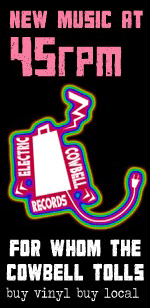
“Vinyl. The sweet smell of petroleum-infused phonographic paradise. As a kid, I loved the ritual of holding my newly purchased vinyl LP, tearing off the shrink wrap, and releasing the mysterious aromatic scent of a fresh LP. When the neighborhood cool kids proclaimed The Clash’s “London Calling” a must-have album, I skateboarded down to the nearby record store and exchanged my lawn-mowing money for a vinyl copy. CDs were OK for new music, I rationalized, but since the album was originally recorded for vinyl back in 1979, I wanted to hear it the way Joe Strummer, Mick Jones and company had originally envisioned it. I was going to party like it was 1979.
With my new purchase in hand, my friends and I ran into my bedroom, and plopped down in front of my record player as I slid a fingernail down the lips of the LP cover, splitting open the cellophane. Poof. Instant LP incense permeated the room. When I dropped the needle down and heard the blast of those first jagged guitar stabs introducing the title track, we all smiled as if we were privy to an inside joke. We always loved the first few moments of listening to a new album for the first time.
I was a little kid, so it was well before Myspace, iTunes and other online services gave you peeks into new bands. Finding new music was mostly earned by word of mouth from friends and self-discovery. So when we’d listen to a new album together for the first time, there was a collective anticipation of discovery and (hopefully) pleasure of our new find.
But it wasn’t always so easy for young music listeners to find new music. It took an even bigger discovery more than 100 years ago to bring songs to our speakers today. Back in 1877, Thomas Edison knew that sound consists of vibrating air that strikes our eardrums (something that Zeppelin drummer John Bonham maximized a century later). Our brain decodes these vibrations as sounds. The number of vibrations per second is the frequency, and the size of these vibrating waves are then interpreted as loudness or softness. Edison’s original phonographs used this principle to transfer sound from a tinfoil sheet to a stylus and then to a barrel-looking horn that blasted crooners into great grandmas living room.
Fast forward 100 years. Four 13 year olds were sitting on the floor around a turntable, watching the LP spin around and around while angry guitars distorted through paper speakers. If Edison’s theory was that the size of the vibrating sounds produced are then interpreted by our brains as loudness and softness, then I was convinced my brain was hungry only for loudness. We cranked the stereo knob to 10 and just nodded to the beats.
“London Calling” had temporarily morphed us into one collective tympanic membrane. We moved and swayed in unison, unaware of how absolutely ridiculous we must have looked. But we were oblivious. Music had taken over our teen brains and all other senses were anesthetized. Rendered useless. The only thing that mattered was Paul Simonon’s gargantuan bass lines, Joe Strummer and Mick Jones trading their attacking guitar melodies and voices, and the beats anchored by Topper Headon.
As a double-album, it was 66 minutes of escape from suburbia. It was escape from the chores my mom would surely ask me to do when she finished doing her exercises in front of the television upstairs. It was escape from Mr. William’s math homework. It was beautiful. —Dave Einmo
Head Like A Kite’s Official Site | Myspace | Facebook | Twitter







